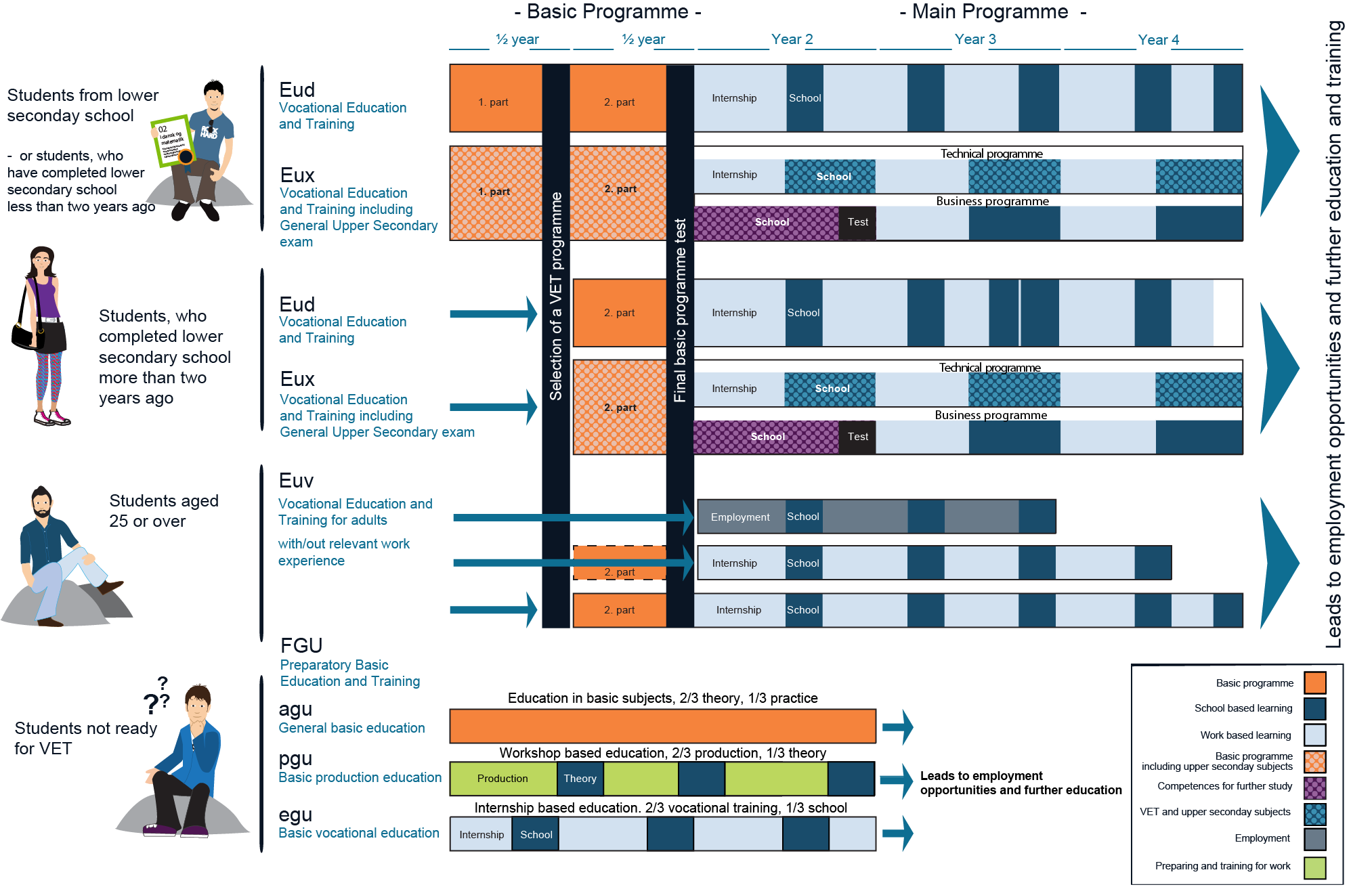Vocational education and training in Denmark
Get access to a career as a skilled worker in Denmark.
The demand of vocational education and training
The vocational education and training system (VET-system) offers more than 100 different types of vocational educations. You can become a carpenter, hairdresser, gardener, electrician or several other skilled professions which are in demand in the labour market.. Each of the educations can lead to a number of vocational specializations. The social partners have considerable influence on and great responsibility for VET.
The majority of the VET-programmes is practical training in an approved company or organization.
The VET consists of a basic programme. The basic programme finishes with an examination and then follows a main programme. The basic programme is a school-based course, while the main programme is build upon the dual principle, where the students alternate between school and apprenticeship.

Download VET overview for higher resolution (pdf)
Further education
All VET programmes are providing graduates access to further education and training. In the VET system one level of qualification is providing access to the next. All VET-programmes are also providing full or conditional access to higher education programmes and further adult education programmes at EQF level 5 and level EQF 6.
Eux
The Danish VET-system offers a VET-programme, which combines a general upper secondary education and vocational education and training – eux. Eux qualifies students for a job as well as giving them direct access to higher education in a wide range of programmes, i.e. leading to a journeyman’s certificate as well as the general upper secondary diploma.
Euv
People above 25 years have access to VET programmes designed especially for adults on the basis of recognition of prior learning and relevant work experience, which leads to the same vocational qualifications.
Admission requirements
Admission to VET usually requires completion of compulsory education and a school leaving certificate obtaining the minimum grade 2.0 in Danish and math or the student starts with on-the-job training in a business enterprise in case they have signed a training agreement with the enterprise.
In order to be admitted to a VET-programme on the basis of a non-Danish qualification, its level must be comparable to the lower secondary (Folkeskole) leaving certificate.
Before entering VET the student is required to document an exam grade average equivalent to 2.0 or higher in the following subjects:
- Mathematics
- The language of instruction or Danish (in case Danish was taught as a first language as part of your school education)
It is up to the vocational college to decide whether the applicant fulfil the entry requirements.
Basic programme (The first year)
Vocational education and training consist of a basic programme divided into two basic courses and the main programme. VET-students enrolled directly after compulsory school will start on the first basic course, which older students can’t. They enroll directly in the second basis course. The length of each of the two basic courses is 20 weeks.
Basic course #1
The first part of the basic course (20 weeks) is for students who have just finished compulsory educations.
The course will give the student a broad vocational knowledge and competences. The student will get an overview of the different programmes in order to choose the right vocational education and training.
Basic course #2
The second part of the basic programme takes place within the vocational education and training programme, that the student has chosen. The course finishes with an examination and then follows the main programme. The basic programme is a school-based course, while the main programme is build upon the dual principle, where the students alternate between school and apprenticeship.
Main subject areas
The four main subject areas of the Danish VET system are:
- Care, health and pedagogy
- Administration, commerce and business service
- Food, agriculture and hospitality
- Technology, construction and transportation
Main programme
Duration
The main programme of the Danish VET is based on the alternating principle typically organized as 4-5 periods of school-based education and training at the workplace. The students must therefore have a training agreement with an approved company which offers training. The main programme typically takes 3 to 3½ years, but can be shorter or longer for certain programmes. Main programmes are offered at EQF level 3 (1,5 years), at EQF level 4 (3 years) and some programmes at EQF level 5 ( 5 years).
Completion
VET-programmes are normally completed with a journeyman’s test or a similar examination testing vocational knowledge, skills and competences.
New apprenticeship
Students who prefer practical training to school can set their vocational education in a company which offers practical training, also referred to as the “New Apprenticeship”: The student enters a training agreement with a company and during the first year the student is expected to acquire the same knowledge and qualifications as the students who have followed the basic programme at a VET college. This requires flexibility on the part of the student, the company and the college.
